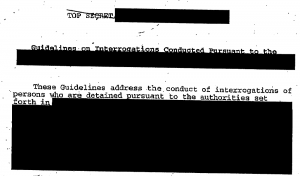Colleen McMahon’s Cheshire Cat: CIA’s Stephen Preston
 As you no doubt remember from Alice in Wonderland, the Cheshire Cat keeps disappearing. Indeed, the cat’s habit of disappearing at will presents an insurmountable challenge to the Queen’s normally simple rules on executions.
As you no doubt remember from Alice in Wonderland, the Cheshire Cat keeps disappearing. Indeed, the cat’s habit of disappearing at will presents an insurmountable challenge to the Queen’s normally simple rules on executions.
When [Alice] got back to the Cheshire Cat, she was surprised to find quite a large crowd collected round it: there was a dispute going on between the executioner, the King, and the Queen, who were all talking at once, while all the rest were quite silent, and looked very uncomfortable.
The moment Alice appeared, she was appealed to by all three to settle the question, and they repeated their arguments to her, though, as they all spoke at once, she found it very hard indeed to make out exactly what they said.
The executioner’s argument was, that you couldn’t cut off a head unless there was a body to cut it off from: that he had never had to do such a thing before, and he wasn’t going to begin at HIS time of life.
The King’s argument was, that anything that had a head could be beheaded, and that you weren’t to talk nonsense.
The Queen’s argument was, that if something wasn’t done about it in less than no time she’d have everybody executed, all round. (It was this last remark that had made the whole party look so grave and anxious.)
Alice could think of nothing else to say but ‘It belongs to the Duchess: you’d better ask HER about it.’
‘She’s in prison,’ the Queen said to the executioner: ‘fetch her here.’
And the executioner went off like an arrow. The Cat’s head began fading away the moment he was gone, and, by the time he had come back with the Duchess, it had entirely disappeared; so the King and the executioner ran wildly up and down looking for it, while the rest of the party went back to the game.
While Judge Colleen McMahon’s reference to Alice was probably just an offhand reference, I submit that she’s got a Cheshire Cat right in the middle of her ruling: CIA General Counsel Stephen Preston and the Gloves Come Off Memorandum of Notification.
As you read her ruling, it’s helpful to remember that she has seen some materials that plaintiffs ACLU and NYT have not. Moreover, this ruling was not sufficient to her argument. She has also written a classified Appendix.
This opinion will deal only with matters than have been disclosed on the public record. The Government has submitted material to the Court ex parte and for in camera review. Certain issues requiring discussion in order to make this opinion complete relate to this classified material. That discussion is the subject of a separate, classified Appendix to this opinion, which is being filed under seal and is not available to Plaintiff’s counsel.
As a threshold matter, then, it is perhaps judicious to assume that any big holes in McMahon’s ruling are dealt with, by necessity, in that Appendix.
There is one obvious, glaring hole (though I am biased, given that I was the first to point to it in the government’s filings): her analysis of whether the government’s searches for documents was adequate. After laying out the relevant standard (page 35), she simply lists the Government’s explanation of its searches–one of which is a classified CIA declaration–and concludes,
This court has reviewed these explanations and concludes that the searches by the responding agencies comported with their statutory obligations.
Again, I’m biased, having pointed out all sorts of reasons why the searches were inadequate, but for McMahon to conclude they were, there must be more compelling evidence in that classified declaration, and she should have to explain how those facially inadequate searches were adequate.
But consider her treatment of a different document I’ve found missing in the past: Preston’s very public speech obliquely covering targeted killing. McMahon acknowledges (page 20) that the plaintiffs have included that in their list of public statements Obama officials have made about targeted killing, but she doesn’t give it the detailed treatment she gives several other speeches by John Brennan, Harold Koh, President Obama, Jeh Johnson, and Eric Holder.
I find that significant given that Preston laid out different logic for the legality of targeted killing than the others did, situating it in Article II rather than in the AUMF.
Preston checks off the first box–authorization under US law before the op–by looking to Article II, not the AUMF Congress passed.
First, we would confirm that the contemplated activity is authorized by the President in the exercise of his powers under Article II of the U.S. Constitution, for example, the President’s responsibility as Chief Executive and Commander-in-Chief to protect the country from an imminent threat of violent attack. This would not be just a one-time check for legal authority at the outset. Our hypothetical program would be engineered so as to ensure that, through careful review and senior-level decision-making, each individual action is linked to the imminent threat justification.
A specific congressional authorization might also provide an independent basis for the use of force under U.S. law. [my emphasis]
That’s interesting for several reasons. First, it situates the authority to use lethal force not in the stated basis OLC is using–the one SCOTUS has affirmed (sort of), but in Article II. Just where John Yoo would look to situate it.
This also means that CIA maintains it has this authority–presuming a Presidential Finding–outside the context of a declared war.
The memo described by Charlie Savage, like all the other speeches, relies on the AUMF.
Mr. Awlaki, who was born in New Mexico, was also accused of playing a role in a failed plot to bomb two cargo planes last year, part of a pattern of activities that counterterrorism officials have said showed that he had evolved from merely being a propagandist — in sermons justifying violence by Muslims against the United States — to playing an operational role in Al Qaeda in the Arabian Peninsula’s continuing efforts to carry out terrorist attacks.
Other assertions about Mr. Awlaki included that he was a leader of the group, which had become a “cobelligerent” with Al Qaeda, and he was pushing it to focus on trying to attack the United States again. The lawyers were also told that capturing him alive among hostile armed allies might not be feasible if and when he were located.
Based on those premises, the Justice Department concluded that Mr. Awlaki was covered by the authorization to use military force against Al Qaeda that Congress enacted shortly after the terrorist attacks of Sept. 11, 2001 — meaning that he was a lawful target in the armed conflict unless some other legal prohibition trumped that authority.
Preston’s speech suggests that if OLC were writing a memo authorizing the CIA to kill Awlaki–as distinct from a memo authorizing DOD to kill him–it wouldn’t necessarily situate the authority in the AUMF. And from that we can surmise that DOJ might have an entirely different memo for CIA than for DOD, with the one described by Savage being the DOD one.
I’ve suspected that’s the case for quite some time (I’ll try to rewrite the 2 very long unpublished posts laying this out).
But I suspect it even more so now.
About 30 pages of McMahon’s opinion addresses why DOD can withhold OLC opinions it has acknowledged. As part of that discussion, she asserts the NYT only wants the DOD opinion.
The Times sole apparent goal at this point is to get a hold of the OLC-DoD Memo, which, it assumes, contains the final legal analysis and justification it seeks.
The ruling doesn’t note this, but I think NYT is doing more than assume here. Savage suggested, after all, that the memo he described was the memo that governed the killing of Awlaki.
But the document that laid out the administration’s justification — a roughly 50-page memorandum by the Justice Department’s Office of Legal Counsel, completed around June 2010 — was described on the condition of anonymity by people who have read it.
So I assume he was told that the memo described to him was the memo that governed the killing a full 15 months later, at a time when CIA had taken over the lead in drone killings in Yemen from DOD.
But McMahon leaves a lot of suggestions that this is not the case, particularly in this long passage explaining why deliberative privilege governs the DOD memo the government has acknowledged. (Thoughout this section, bold emphasis mine, italics McMahon’s, and citations omitted.)
But there is no suggestion, in any of those speeches or interviews, that the legal reasoning being discussed is the reasoning set out in the OLC-DoD Memo, a document which the Government acknowledges exists. This document, unlike the OLC opinions on local enforcement of immigration laws, has never been mentioned in any public statement. For that matter, OLC has never been mentioned in any public statement; none of the speeches attribute any legal principles announced to OLC or to any opinion it has issued.
Indeed, she even quotes from a colleague’s opinion raising the possibility of other memos addressing the same topic.
My colleague Judge Scheindlin noted [in National Day Laborer Organization v ICE], “[U]nless the defendants have unlawfully withheld other legal memoranda from plaintiffs and this Court, it was the only document comprehensively laying out the legal authority for making Secure Communities mandatory. Thus, the analysis in the Memorandum seems to be the only rationale that the agency could have relied upon and adopted as the legal basis for the policy.”
In this case, however, there is no evidence that the Government “continually relied upon and repeated in public the arguments made” specifically in the OLC-DoD Memo. Read more →

